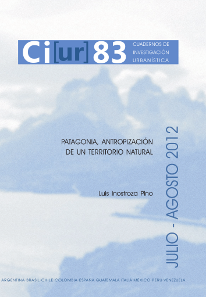Patagonia, antropización de un territorio natural
Palabras clave:
Patagonia, ganadería lanar, petróleo, turismoResumen
La dominación antrópica del territorio como producto de la relación entre base económica, nivel de organización del sistema social y las características ambientales manifiesta en la región de Magallanes cuatro estadios temporales. Un primer estadio correspondiente a la fase de cazadores recolectores, que se desarrolla desde los albores de la ocupación humana - con un breve intento de colonización española en el siglo XVI - y finaliza en el siglo XIX después de la fundación de Punta Arenas. Un segundo estadio de expansión ganadera cimentado sobre la base de la ganadería ovina extensiva que corresponde al periodo más bullente de la economía regional, donde el ecúmene se expande sobre el ecosistema de estepas. Un tercer estadio o fase de explotación petrolera basado en el descubrimiento y posterior explotación de hidrocarburos, que se inicia con las exploraciones de principios del siglo XX que llevaron al descubrimiento de hidrocarburos en 1945. Esta forma de ocupación-explotación comienza a declinar junto con el agotamiento del recurso a finales de la década de 1980. En esta etapa se completa la expansión del modelo de ocupación territorial sobre la totalidad de un ecosistema: la estepa, que deja de ser un ambiente natural después de estas transformaciones y pasa a ser un ecosistema antrópicamente dominado. Actualmente se desarrolla el cuarto estadio o fase de terciarización, que se construye sobre el turismo y apoyado en la diversificación de la ciudad matriz sobre todo tipo de servicios. La base económica vuelve a dar un giro, proyectando nuevas formas de utilización sobre espacios geográficos hasta ahora marginales en la esfera del metabolismo social. El patrón espacial continúa funcionando sobre la base de la ciudad matriz que ejerce el control sobre un amplio hinterland. El turismo tiene su leitmotiv hacia el occidente abriendo la posibilidad de incorporar al tejido productivo una enorme extensión territorial otrora olvidada.
Abstract:
Anthropogenic domination of the territory as a result of the relationship between economic base, level of organization of social and environmental characteristics reveals in the region of Magellan (Chile), four temporary stages. A first stage corresponding to the hunter-gatherer stage, which runs from the beginning of human occupation - with a failed attempt of Spanish settlement in the sixteenth century-to the nineteenth century, after the foundation of Punta Arenas. A second stage of livestock spreading based on the extensive sheep farming which is linked to the wealthiest period of the regional economy, where the ecuneme expands on the steppe ecosystem. The third stage also called the oil-phase with the discovery and exploitation of hydrocarbons, which begins in the early twentieth century and lasts until the discovery of oil in 1945. This form of occupation-exploitation begins to decline with the depletion of the source in the late 1980´s. This fourth stage reaches the entire domination of the ecosystem by the territorial settlement model: the steppe, which is no longer a natural environment after these changes, becomes and anthropogenic ecosystem. At the present, it is being developed the fourth stage or the outsourcing-phase, built on tourism and supported by the diversification of the city matrix over a huge range of services. The economic base is spinning back, leading to new uses over geographic spaces once marginalized in the sphere of social metabolism. The spatial pattern continues operating on the basis of the parent city that rules over a wide hinterland. Tourism owns its leitmotiv towards the Western, bringing up the possibility of assimilating a huge territory, previously forgotten.












